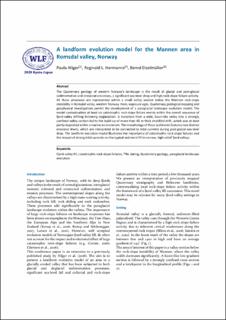| dc.contributor.author | Hilger, Paula | |
| dc.contributor.author | Hermanns, Reginald | |
| dc.contributor.author | Etzelmüller, Bernd | |
| dc.date.accessioned | 2021-04-06T08:20:51Z | |
| dc.date.available | 2021-04-06T08:20:51Z | |
| dc.date.created | 2021-01-21T11:07:17Z | |
| dc.date.issued | 2020 | |
| dc.identifier.citation | Hilger, P., Hermanns, R. L., & Etzelmüller, B. (2021). A landform evolution model for the Mannen area in Romsdal valley, Norway. In V. Vilímek, F. Wang, A. Strom, K. Sassa, P. T. Bobrowsky, & K. Takara (Eds.), Understanding and reducing landslide disaster risk (pp. 309-314). | en_US |
| dc.identifier.isbn | 978-3-030-60319-9 | |
| dc.identifier.issn | 2662-1894 | |
| dc.identifier.uri | https://hdl.handle.net/11250/2736288 | |
| dc.description | This is a post-peer-review, pre-copyedit version of a chapter published in Understanding and Reducing Landslide Disaster Risk. The final authenticated version is available online at: https://doi.org/10.1007/978-3-030-60319-9_34 | en_US |
| dc.description.abstract | The Quaternary geology of western Norway’s landscape is the result of glacial and post-glacial sedimentation and erosional processes, a significant sea-level drop and high rock-slope failure activity. All these processes are represented within a small valley section below the Mannen rock-slope instability in Romsdal valley, western Norway. Here, exposure ages, Quaternary geological mapping and geophysical investigations permit the development of a paraglacial landscape evolution model. The model contextualises at least six catastrophic rock-slope failure events within the overall sequence of fjord-valley infilling following deglaciation. A transition from a wide basin-like valley into a strongly confined valley section led to the build-up of more than 40 m thick stratified drift, which was at least partly deposited within a marine environment. The morphology of these sediments features two distinct erosional levels, which are interpreted to be connected to tidal currents during post-glacial sea-level drop. The landform evolution model illustrates the importance of catastrophic rock-slope failures and the impact of strong tidal currents on the typical sediment fill in narrow, high-relief fjord valleys. | en_US |
| dc.language.iso | eng | en_US |
| dc.publisher | Springer | en_US |
| dc.relation.ispartof | Understanding and Reducing Landslide Disaster Risk Volume 5 Catastrophic Landslides and Frontiers of Landslide Science | |
| dc.subject | fjord-valley fill | en_US |
| dc.subject | catastrophic rock-slope failures | en_US |
| dc.subject | 10Be dating | en_US |
| dc.subject | quaternary geology | en_US |
| dc.subject | paraglacial landscape evolution | en_US |
| dc.title | A Landform Evolution Model for the Mannen Area in Romsdal Valley, Norway | en_US |
| dc.type | Chapter | en_US |
| dc.description.version | acceptedVersion | en_US |
| dc.subject.nsi | VDP::Geofag: 450 | en_US |
| dc.subject.nsi | VDP::Geosciences: 450 | en_US |
| dc.source.pagenumber | 309-314 | en_US |
| dc.identifier.doi | 10.1007/978-3-030-60319-9_34 | |
| dc.identifier.cristin | 1876380 | |
| cristin.ispublished | true | |
| cristin.fulltext | postprint | |
| cristin.qualitycode | 1 | |
